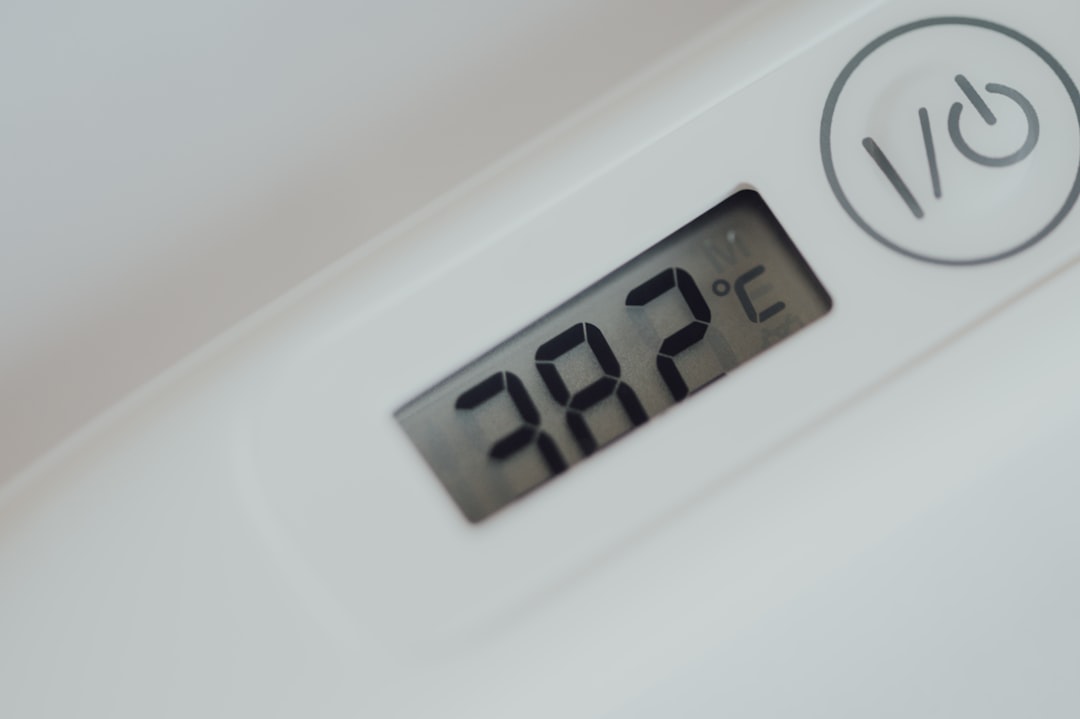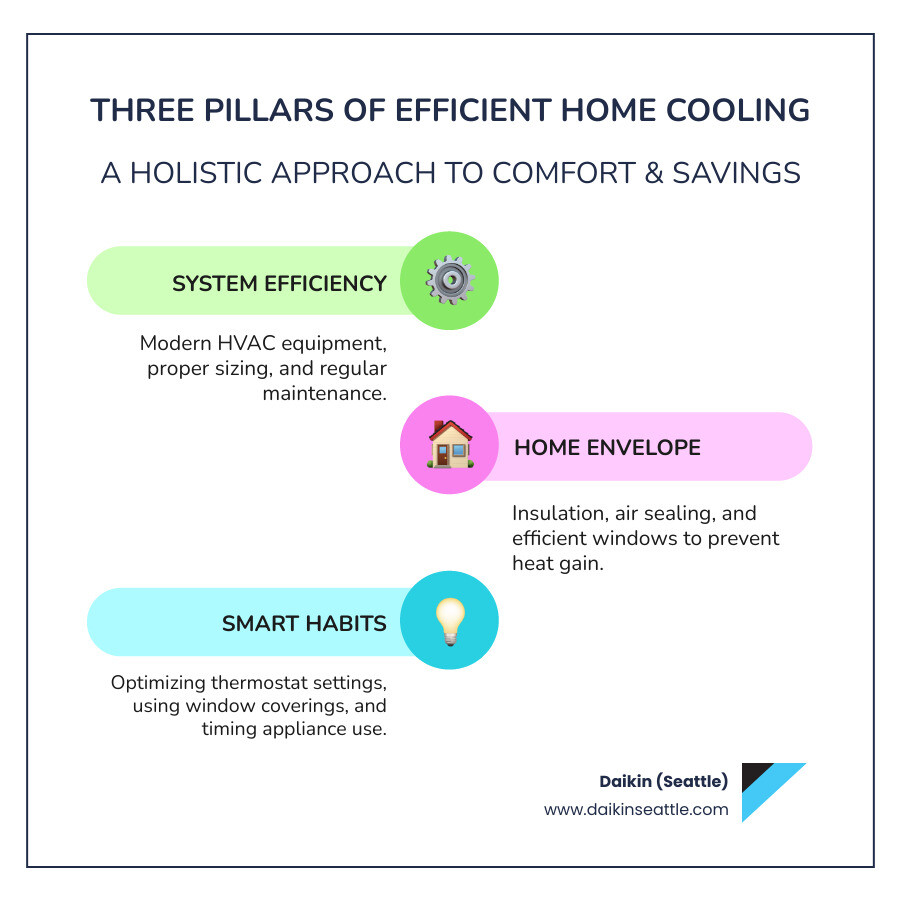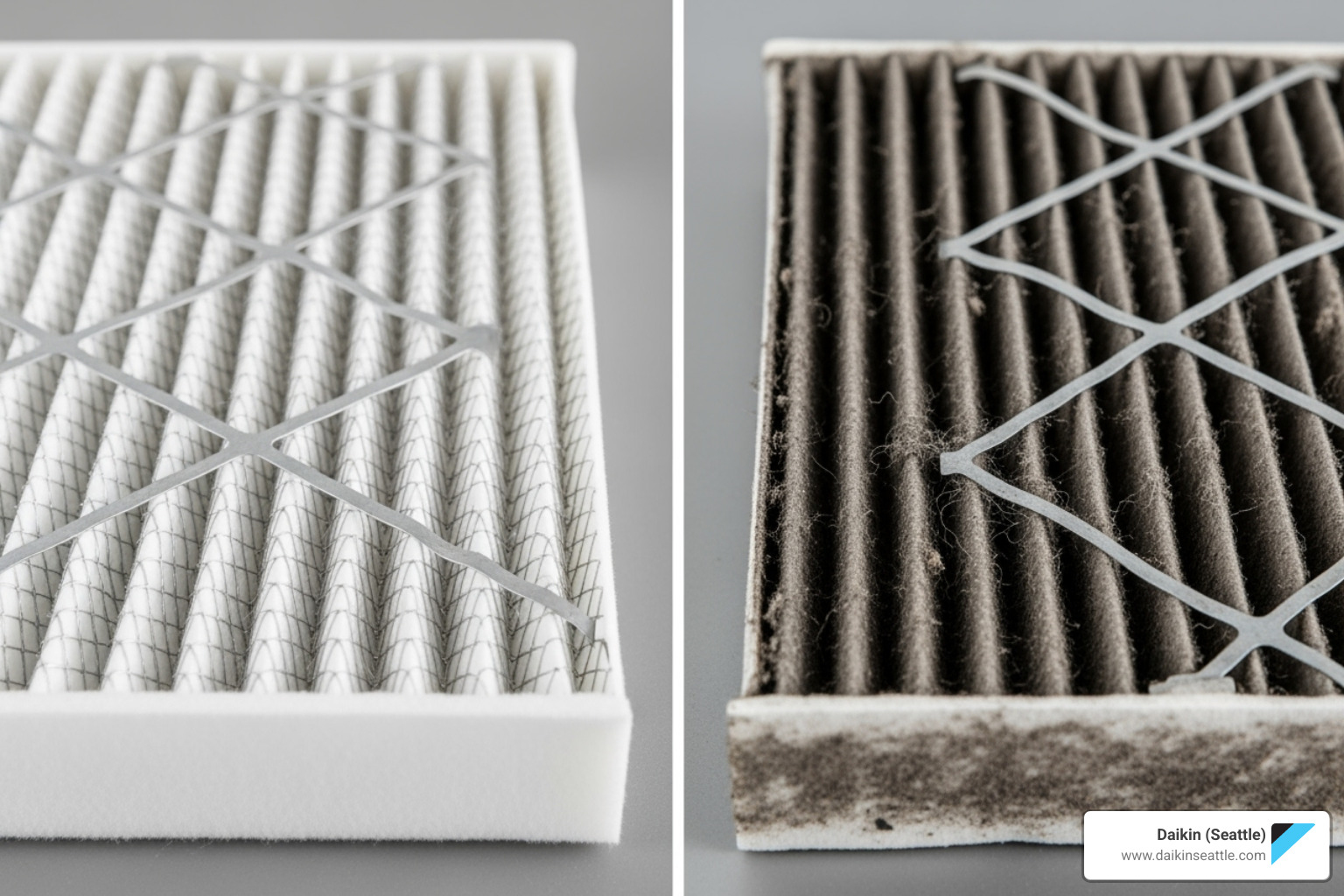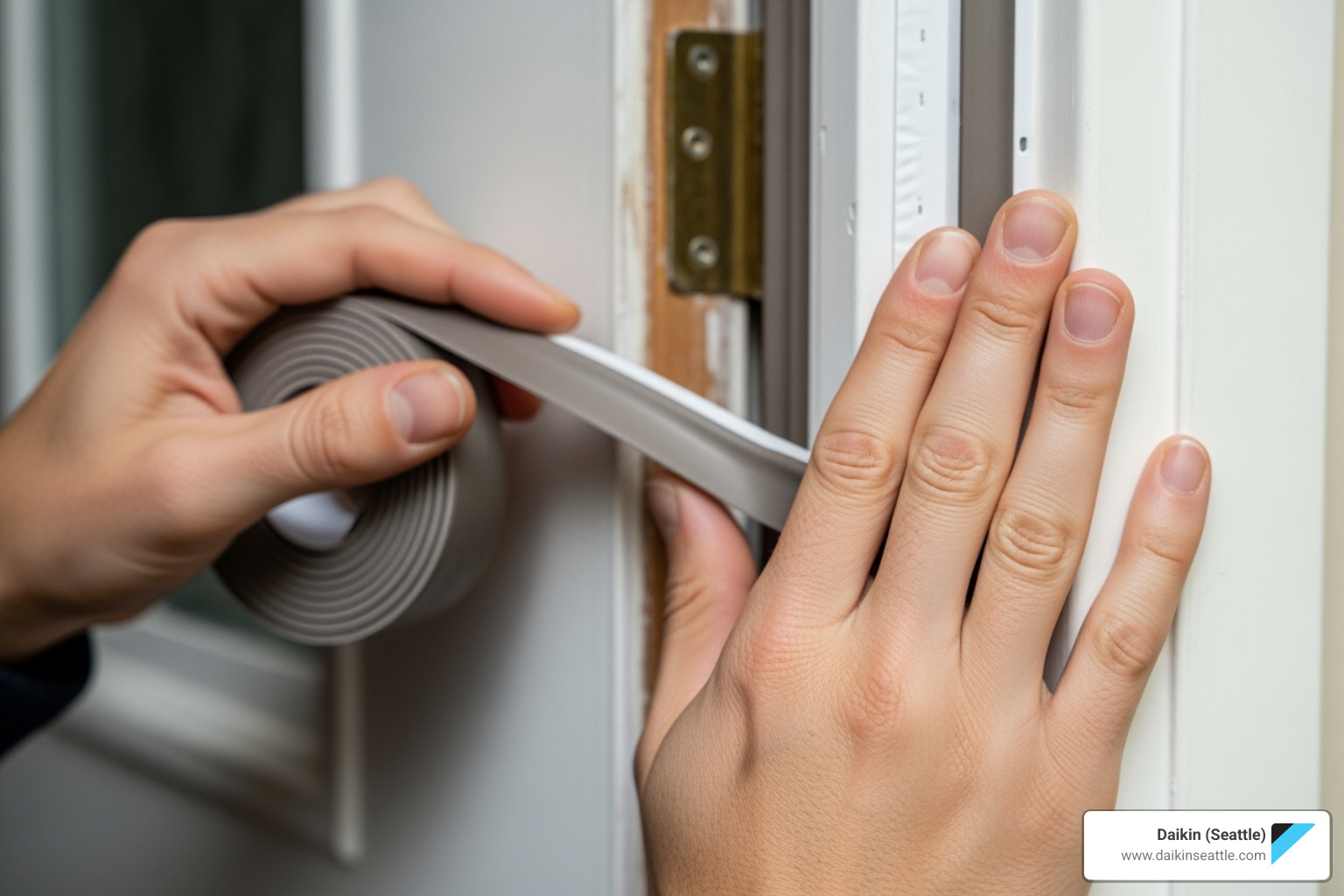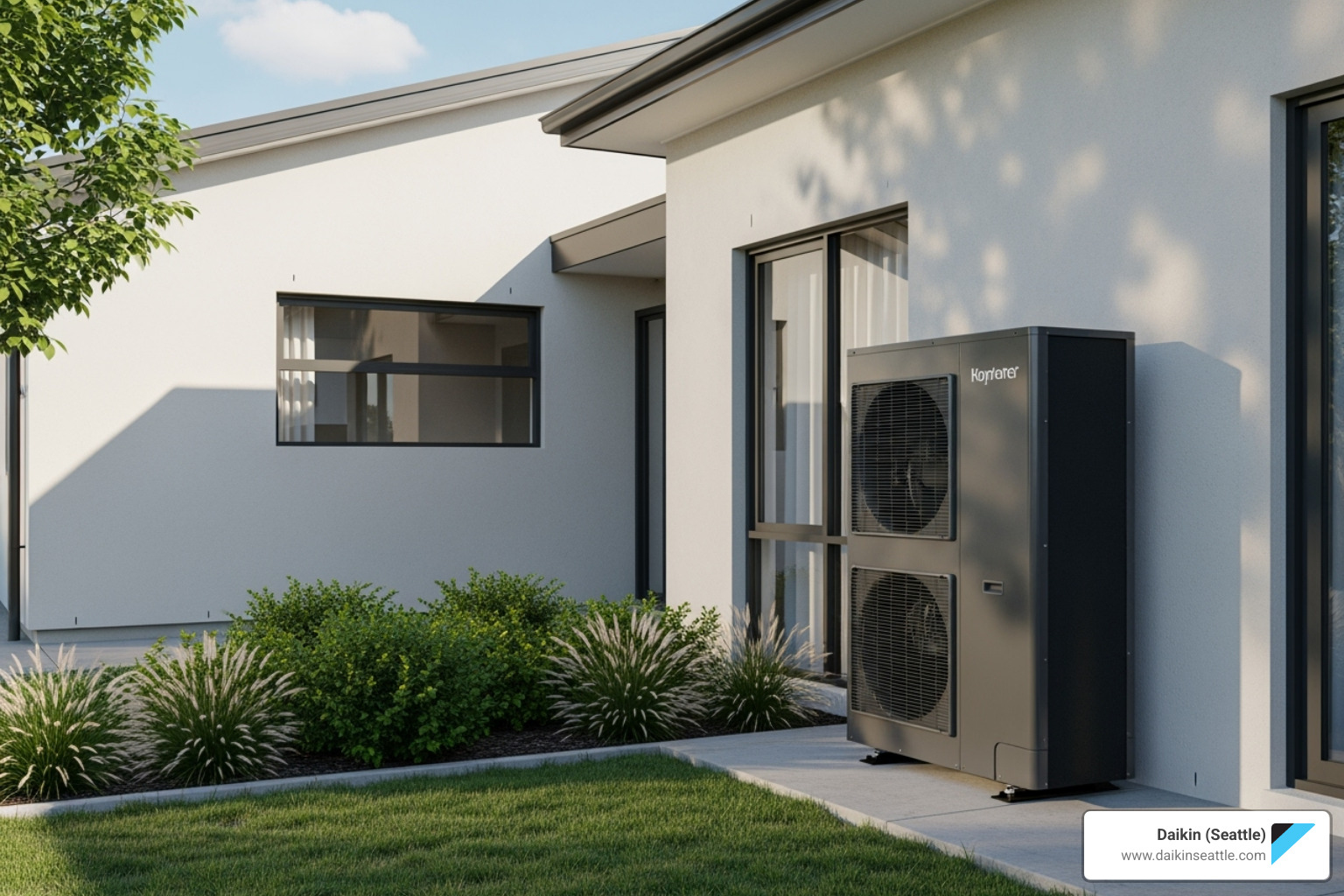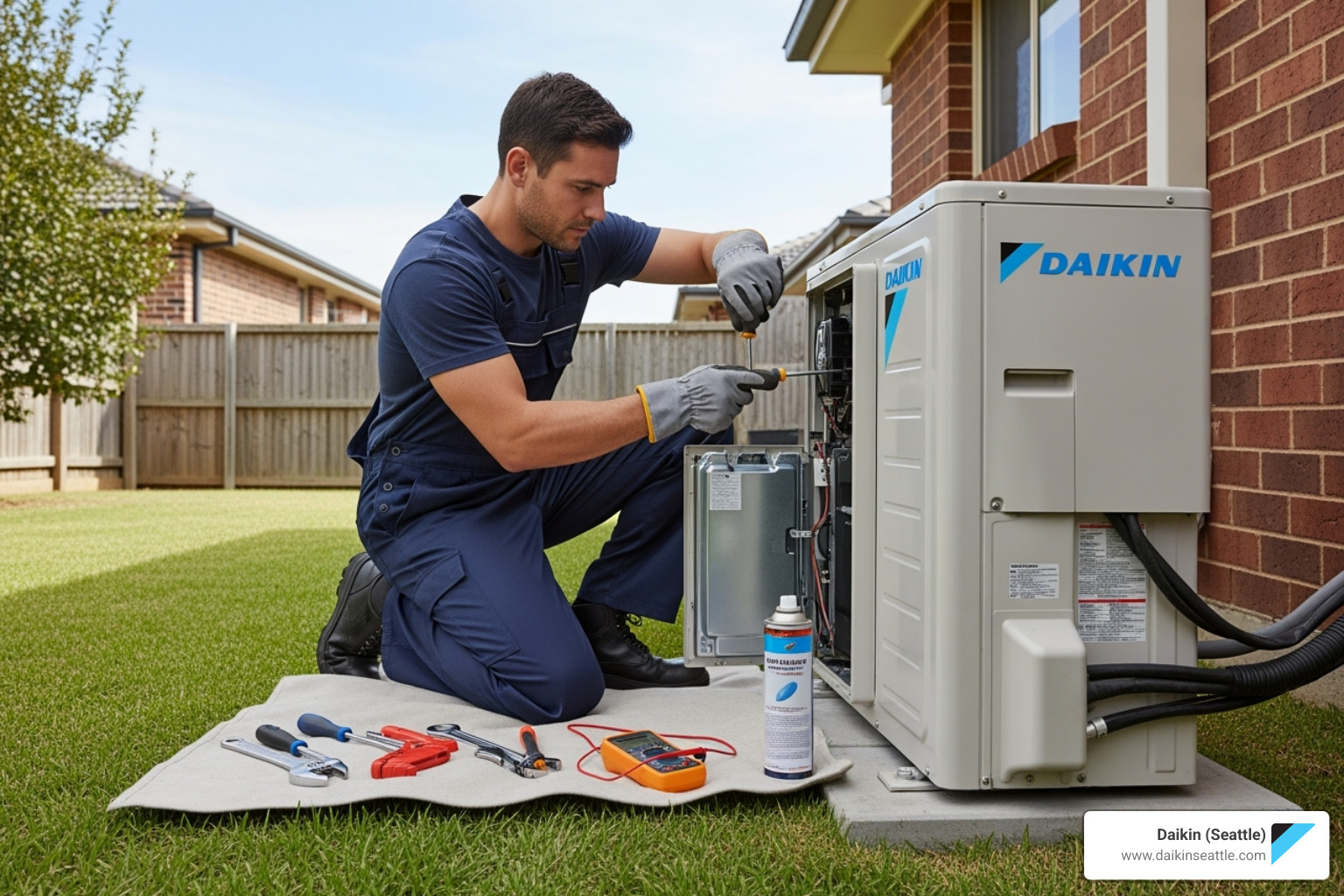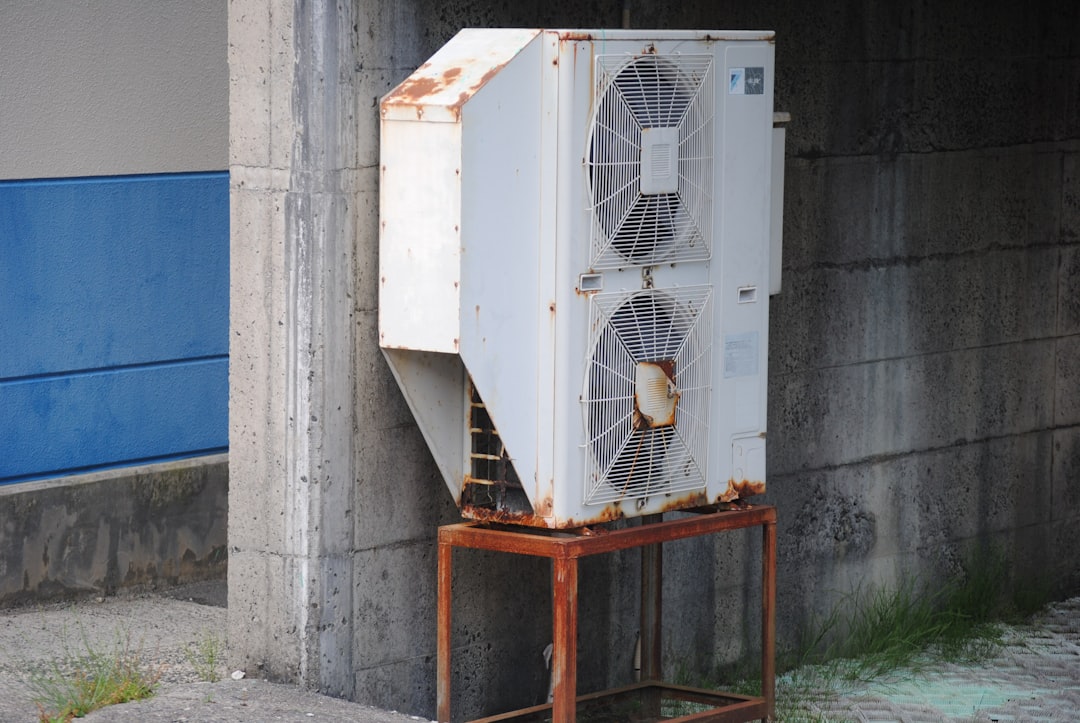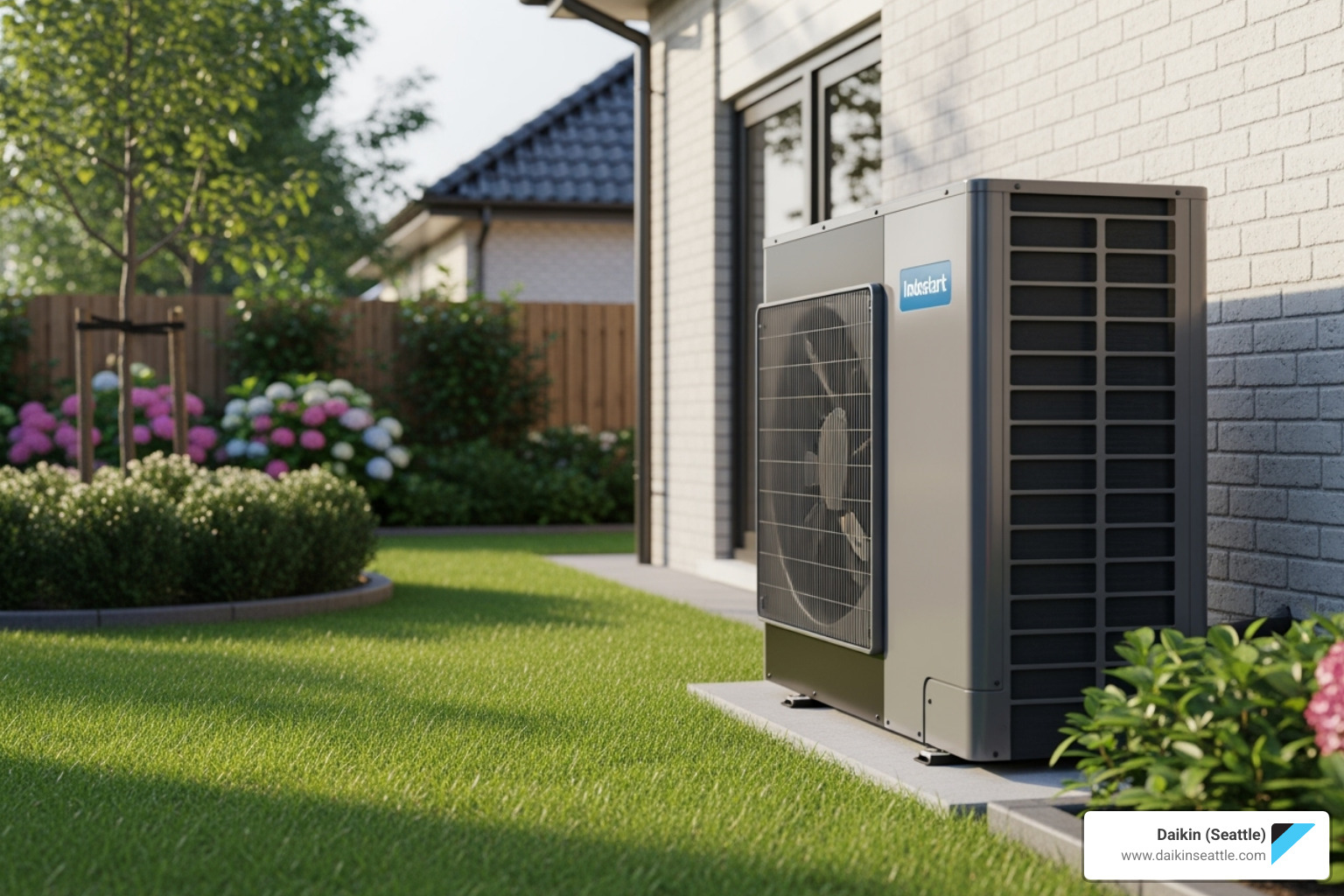Why Efficient Home Cooling Matters More Than Ever
Efficient home cooling is no longer just about comfort; it’s a crucial strategy for managing rising energy costs. With cooling demand projected to triple by 2050, homeowners are facing higher bills and a greater need for effective cooling solutions.
Quick wins for efficient home cooling:
- Set thermostats to 75-78°F to save up to 10% by adjusting 7-10 degrees when away.
- Change AC filters monthly to prevent energy waste and extend system life.
- Use medium-colored draperies to reduce heat gains by as much as 33%.
- Seal air leaks, as 20% of conditioned air can escape through ductwork gaps.
- Consider heat pumps, which are up to 50% more efficient than traditional AC units.
Many homeowners are caught in a “vicious cycle of cooling”: hotter weather leads to more AC use, which in turn means higher bills and a greater environmental impact. The good news is that breaking this cycle is achievable. Modern air conditioners already use 30-50% less energy than older models, but the real secret is a holistic approach that combines smart habits, proper maintenance, and strategic home and system upgrades.
This guide will walk you through the strategies to achieve better cooling while spending less money—a win-win for your comfort and your wallet.
Smart Habits & Low-Cost Cooling Hacks
Before spending money on major upgrades, you can achieve significant efficient home cooling with simple habits and low-cost adjustments. These passive cooling techniques work by preventing heat from entering your home in the first place, saving you money on energy bills.
Master Your Thermostat for Effortless Savings
Your thermostat is the brain of your cooling system. The Department of Energy recommends setting it between 75-78°F during the day. While this may sound warm, homeowners can save up to 10% on heating and cooling by adjusting the temperature back 7-10 degrees for eight hours a day, such as when you’re at work or asleep.
A programmable thermostat automates this process, while smart thermostats take it a step further. They learn your schedule, allow for remote control via your phone, and an ENERGY STAR certified model can save around $100 per year. If your home has zone control, you can further increase efficiency by focusing cooling only on the rooms you’re using.
Every degree counts, and finding the right balance between comfort and savings will make a noticeable difference on your energy bill. For more guidance, see our guide on choosing the right HVAC system.
Harness the Power of Fans and Ventilation
Fans cool you, not the air, by creating a wind chill effect. This allows you to set your thermostat a few degrees higher without sacrificing comfort.
- Ceiling Fans: In summer, set blades to spin counter-clockwise. This pushes cool air down, creating a pleasant downdraft.
- Strategic Ventilation: On cooler evenings, open windows on opposite sides of your home and use box fans to create a cross-breeze. Place fans facing inward on the cooler side and outward on the warmer side to flush out hot air. Avoid this when outdoor temperatures are above 95°F.
- Exhaust Fans: Use kitchen and bathroom exhaust fans to remove heat and humidity from cooking and showers. Run them only as needed to avoid pulling conditioned air outside. For optimal performance, consider high-efficiency, low-noise ENERGY STAR models.
- Nighttime Ventilation: When temperatures drop after sunset, open windows and use fans to cool your home naturally for the next day.
Block Out the Sun, Not the View
Your windows can act like giant heat magnets. Stopping solar heat before it enters is a key strategy for efficient home cooling.
- Window Coverings: This is your most affordable defense. Medium-colored draperies can reduce heat gains by 33%, especially those with white-plastic backings. Keep them closed on east and west-facing windows during the sunniest parts of the day. Blinds, shades, and window films are also effective.
- Exterior Shading: Landscaping is a natural cooling system. Plant deciduous trees on the south and west sides of your home for summer shade and winter sun. Awnings and pergolas also work well, stopping heat before it even reaches your windows, which is far more effective than interior coverings alone.
Every ray of sun you block is energy your AC doesn’t have to use, leading to a cooler home and a lower energy bill.
Optimize Your Current HVAC System for Peak Performance
Once you’ve mastered smart habits, it’s time to focus on your HVAC system. You don’t necessarily need a new unit to see improvements in efficient home cooling. Proper maintenance and operation can boost your existing equipment’s performance, lower bills, and extend its life.
The Importance of Regular HVAC Maintenance
Like any complex machine, your air conditioner needs regular care to run efficiently. Neglecting maintenance can lead to poor performance and costly breakdowns.
- Change Your Air Filter: This is the simplest, most critical task. Check your filter monthly during peak cooling season and change it at least every three months. A clogged filter forces your system to work harder, wasting energy.
- Clear Your Outdoor Unit: Ensure your outdoor condenser has at least two feet of clearance on all sides. Trim back bushes and remove leaves or debris that could block airflow and reduce efficiency.
- Schedule Annual Tune-Ups: A professional HVAC service is invaluable. A technician will check refrigerant levels, clean coils, and identify minor issues before they become major problems. Since improper installation can reduce efficiency by up to 30%, professional maintenance ensures your system runs as intended.
For more tips, explore our resources on Energy Efficient HVAC Systems.
A Guide to Efficient Home Cooling with Your Existing AC
Small changes in how you operate your AC can lead to big savings.
- Use the “Auto” Fan Setting: Always choose “auto” over “on.” The “on” setting runs the fan continuously, wasting electricity and reducing your system’s ability to dehumidify the air. The “auto” setting ensures the fan only runs when the system is actively cooling.
- Avoid Overcooling: Cranking the thermostat down to 65°F won’t cool your home faster, but it will dramatically increase your energy bill. Stick to the optimal 75-78°F range for efficient comfort.
- Manage Unused Spaces: Close doors and vents to rooms you aren’t using. This focuses your system’s cooling power where it’s needed most.
- Reduce Indoor Heat: Run heat-generating appliances like ovens, dryers, and dishwashers during cooler parts of the day. Switching to LED bulbs also helps, as they produce far less heat than incandescent ones. These small adjustments reduce your home’s overall cooling load.
The Whole-Home Approach to Efficient Home Cooling
Think of your home as a cooler. If it has cracks, the cool air escapes and hot air gets in, forcing your AC to work overtime. A whole-home approach addresses this by improving your home’s “envelope”—the barrier between your conditioned indoor space and the outdoors.
Seal the Leaks: Your First Line of Defense
Air leaks around windows, doors, and pipe penetrations are energy vampires. Air sealing is one of the most cost-effective ways to boost efficiency.
- DIY Sealing: Use weatherstripping around doors and windows and apply caulking to seal cracks and gaps on your home’s exterior.
- Professional Energy Audit: For a comprehensive solution, a professional energy audit can identify hidden leaks in your attic, basement, and walls using tools like blower doors and infrared cameras.
Sealing leaks creates a more stable, comfortable environment and allows your AC to work more effectively. It can also improve your home’s health. Learn more in our guide on Indoor Air Quality Seattle.
Don’t Let Cool Air Escape: The Truth About Ductwork
Did you know that 20% of the air moving through a home’s duct system is often lost to leaks? This means you could be paying to cool your attic or crawl space. Since ducts are usually hidden, they are often overlooked.
Leaks are most problematic in unconditioned spaces like attics. A professional can seal these leaks with mastic sealant or specialized metal-backed tape (which is far more durable than standard duct tape).
Professional duct sealing can improve your system’s efficiency by 20% or more, ensuring cool air is delivered where you need it. This leads to better comfort and lower energy bills.
The Overlooked Heroes: Insulation and Windows
Insulation and windows are critical components of efficient home cooling, working 24/7 to keep heat out.
- Insulation: This acts as a thermal shield. The attic is the most critical area to insulate. Wall and crawl space insulation are also important for creating a complete thermal barrier. Insulation is measured in R-value; higher numbers mean better heat resistance.
- Windows: Old, single-pane windows are a major source of heat gain. Upgrading to energy-efficient windows with multiple panes and special coatings can make a dramatic difference. Look for ENERGY STAR certified windows, which meet strict efficiency guidelines and significantly reduce heat transfer.
Combining proper insulation and efficient windows with strategic landscaping creates a home that stays naturally cooler, reducing the strain on your air conditioner.
Upgrading Your System: The Ultimate Efficiency Investment
While maintenance and home improvements are essential, there comes a time when investing in new technology is the smartest move for long-term comfort and savings. An old, inefficient cooling system can undermine all your other efforts.
Is It Time for a New System?
Replacing a system that’s still running can feel premature, but watch for these signs that it’s time for an upgrade:
- Age: If your AC is over 10 years old, it’s likely far less efficient than modern units. You may save 20 to 40% of your cooling energy costs by replacing a 10+ year model with a new, efficient one.
- Frequent Repairs: If repair bills are piling up, that money could be better invested in a new, reliable system.
- High Energy Bills & Poor Comfort: If your bills remain high despite efficiency efforts, or if your home has hot spots and high humidity, your system is likely struggling.
Investing in a new ENERGY STAR certified system can cut your annual energy bill by nearly $140 and dramatically improve comfort.
Heat Pumps vs. Traditional AC: The All-in-One Solution for Efficient Home Cooling
Heat pumps are a game-changer in home comfort. Unlike traditional air conditioners that only cool, heat pumps provide both heating and cooling in one highly efficient unit.
They work by moving heat rather than creating it. In summer, a heat pump extracts heat from inside your home and moves it outside. In winter, it reverses the process, pulling heat from the outdoor air to warm your home. This process makes them incredibly efficient—heat pumps are up to 50% more efficient than standard AC units for cooling and are excellent at dehumidification.
At Daikin, our advanced inverter heat pump technology precisely controls output for maximum efficiency and quiet, consistent comfort. You can see these systems at our unique Pacific Northwest Daikin Experience Center in Seattle. Learn more about our Heat Pump Solutions Seattle.
Decoding Efficiency Ratings: What SEER & EER Mean for You
Understanding efficiency ratings is key to making a smart investment. Two important ratings are EER and SEER:
- EER (Energy Efficiency Ratio): Measures cooling efficiency at a specific, fixed outdoor temperature. A higher EER means better efficiency.
- SEER (Seasonal Energy Efficiency Ratio): Measures efficiency over an entire cooling season with varying temperatures, giving a more realistic picture of annual performance. The minimum SEER for new ACs is 13, but high-efficiency models go much higher.
The higher the SEER or EER rating, the less electricity the system uses, which translates directly to lower monthly bills. For more details, see our resource on Power Efficiency in Cooling Systems.
Here’s how upgrading your SEER rating can impact your annual energy costs:
| Old System SEER | New System SEER | Annual Energy Cost (Example)* | Potential Annual Savings |
|---|---|---|---|
| 8.0 | 14.0 | $500 | $214 |
| 10.0 | 16.0 | $400 | $150 |
| 12.0 | 18.0 | $350 | $117 |
*These are illustrative examples. Actual savings vary based on your climate, usage, and local energy rates.
Frequently Asked Questions about Home Cooling
We’ve helped countless homeowners achieve efficient home cooling. Here are answers to some of the most common questions we hear.
How much can I really save with a smart thermostat?
The savings are significant. ENERGY STAR certified smart thermostats can save approximately $100 a year in homes with high energy bills or that are empty for long periods. Your actual savings depend on your habits. If you already adjust your thermostat manually, the savings will be smaller. But for most people, the automated scheduling and remote access of a smart thermostat provide both convenience and real energy savings.
Is it more efficient to leave the AC on all day or turn it up when I leave?
Energy experts agree: it’s more efficient to turn your thermostat up 7-10 degrees when you’re away for several hours. Your AC uses less total energy to cool the house back down than it does running all day to maintain a constant low temperature. The key is to not turn it off completely, which can force the system to work too hard to recover. A programmable or smart thermostat can automate this process, cooling your home just before you return.
What’s the most important first step to improve my home’s cooling efficiency?
For the biggest immediate impact with no cost, start with smart habits: optimize your thermostat settings, use fans, and block sunlight with window coverings. If you’re ready for a project, sealing air leaks and improving insulation typically provides the best return on investment. There’s no sense in paying for cool air if it’s just leaking outside. Finally, don’t forget regular HVAC maintenance. Changing filters and getting an annual tune-up ensures your current system runs as efficiently as possible.
Conclusion: Your Path to a Cooler, More Efficient Home
The journey to efficient home cooling is about combining multiple strategies into a holistic approach that fits your home and lifestyle. It’s a layered process that builds on itself for maximum impact.
Start with the simple, no-cost habits: adjusting your thermostat, using fans, and blocking the sun. Then, optimize your current equipment with regular HVAC maintenance.
From there, improve your home’s envelope by sealing air leaks, improving insulation, and upgrading windows. These steps create a home that naturally stays cooler and provides long-term financial benefits.
Finally, when it’s time for an upgrade, modern high-efficiency systems like heat pumps offer the ultimate in savings and comfort. At Daikin, we specialize in helping you steer these choices to find the perfect solution for your home’s unique needs.
You don’t have to do everything at once. Start with the changes that fit your budget today and gradually build toward a home that is not just cooler, but more comfortable, sustainable, and affordable to operate.
Ready to take the next step? Explore multi-zone HVAC system solutions in Seattle to learn how we can tailor cooling comfort to every room in your home.

